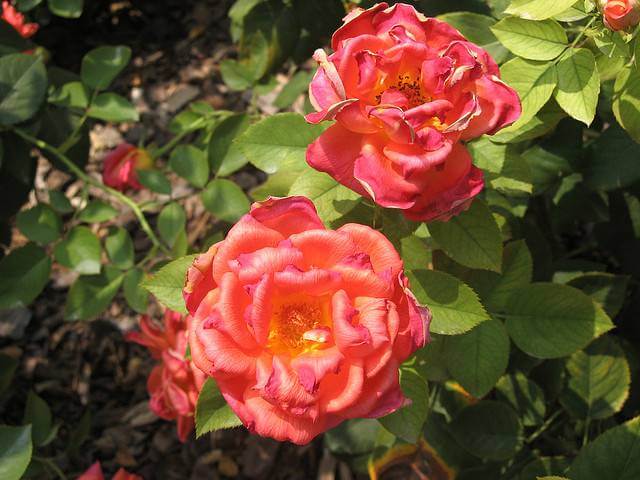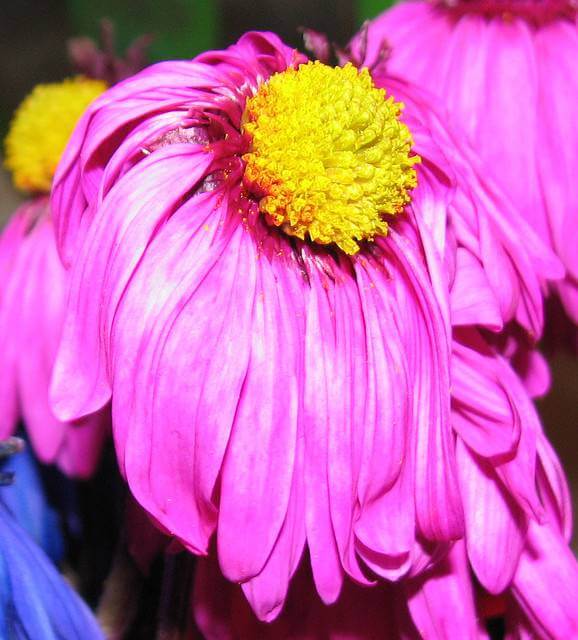The dog days of summer are here, and with them come hard times for some of our precious flowers, whether they are cut, potted, or in the garden. One of the unsightly symptoms of heat distress is wilting: Bbelieve it or not, in hot weather, wilting is kind of like the plant version of sweating! There are some steps that you can take to make your flowers more comfortable in the heat and to perhaps prevent wilting. Here are some tips I have put together for you.
What Causes Wilting?

Photo by Selena N.B.H. (Flickr)
In order to defeat your enemy, you must know it, as the saying goes. There are a variety of reasons that plants wilt; bacterial, fungal, and viral diseases are some causes, as well as over-watering and too little sun. So how do you know that your flowers are wilting from the heat? Generally, if it is above 86 degrees, especially in a dry, windy climate, there is a good chance wilting is due to heat distress. If the leaves of your plant wilt during the day but are fine by the next morning, the wilting is probably due to heat. Areas on your flowers and leaves that are brown, yellow, or white are other symptoms of extreme heat and sun exposure, as are dropped buds. Wilting because of hot and dry conditions occurs because plants are releasing moisture through transpiration faster than they can take water up in their roots and distribute it to the leaves. Transpiration occurs at a higher rate in hot weather as a way of regulating the plant’s temperature, like sweating in humans. Wilting also serves to protect the plant’s leaves from the sun. When your plants wilt, it is a sure sign they need a little extra TLC; prolonged wilting can lead to susceptibility to diseases and pests and, in the worst cases, even death.
Practice Good Gardening

Photo by Eric Skiff (Flickr)
The best way to prevent wilting in plants is to take good care of them from the start. Regular, deep, and consistent watering at the roots of a plant will allow it to develop a healthy, extensive root system. Weeding, well-drained soil, regular feeding in appropriate amounts, and pest control also contribute to healthy plants with strong roots, which will protect the plant against wilting. Most sources say to water in the early morning, when it is cooler, to prevent excessive evaporation from heat; I have also heard of people watering at night in very hot, dry climates. The concern with watering at night is that it could lead to fungal diseases if water stays on the leaves all night. Mulching is a great way to hold in moisture and protect roots from the sun. You may want to consider planting an indicator plant that will wilt before your other plants get the chance to; that way, you can take action before your prized flowers start wilting.
Plant Heat-Tolerant Varieties or Plant in Micro-Climates
If you live in an area where you experience hot summers and plants are prone to wilting, you may want to look into planting native flowers or heat-tolerant varieties. Cupheas, blanket flower, moss rose, and rudbeckia are a few heat-tolerant flowers to consider. Research your plants: Some plants are notorious for wilting, like hydrangeas. If you have such a plant, plant them somewhere in your garden where they will receive morning sun but be shielded from afternoon and evening sun. If nothing else, you can use shade cloths and misting to protect distressed plants. Planting in shaded areas creates a micro-climate that is cooler than the rest of the garden.
Special Considerations for Container Plants
As with plants in the ground, the best way to prevent wilting in container plants is good care from the start; however, there are some other things to consider with container plants. Potted plants do not have as much soil to hold moisture, so they dry out much more quickly than plants in the ground, especially in hot, dry, sunny weather. I make sure to check my container plants every day when it is hot. If you have especially small containers, you may need to check them several times a day and water. Unglazed terra cotta pots lose water more quickly than glazed or plastic pots, and dark-colored pots absorb more heat, which can hurt roots. It is a good idea to have a saucer under the pot so that the plant has a chance to suck up more water, although you should not leave a plant standing in water for a long time. I love container plants because if I notice them wilting, I can easily move them to a shadier area during the hottest days or hottest part of the day and then move them back.
Preventing Wilting in Cut Flowers

Photo via Courtney Rhodes (Flickr)
If you are cutting your own flowers from the garden, take my advice and do it early in the morning; plants are at their freshest at this time of the day, and if it is hot, this is the coolest part of the day, when they are not yet wilting. It is a good idea to carry a bucket of water with you so that you can put them in water immediately after cutting the stems with a sharp knife. If you are purchasing flowers from a florist or store, ask for a damp paper towel to wrap the stems in if you have a long drive home: I always offer customers this option. Going without water is a big cause of drooping in cut flowers. Once you are home, cut the stems under running water. Add floral preservative to a clean vase of water, or make your own, and add a teeny-tiny drop of bleach to keep bacteria from growing. Changing the water every day and stripping the bottom leaves keeps bacteria from growing as well; preventing bacterial growth will prolong the life of cut flowers. Keeping flowers out of direct sunlight or hot spots and in a cool room will also keep them from wilting and prolong their lives, the way a florist’s cooler does.
![[Avas Flowers] Avas Flowers](https://www.avasflowers.net/newimg/avas-logo-new.png)
